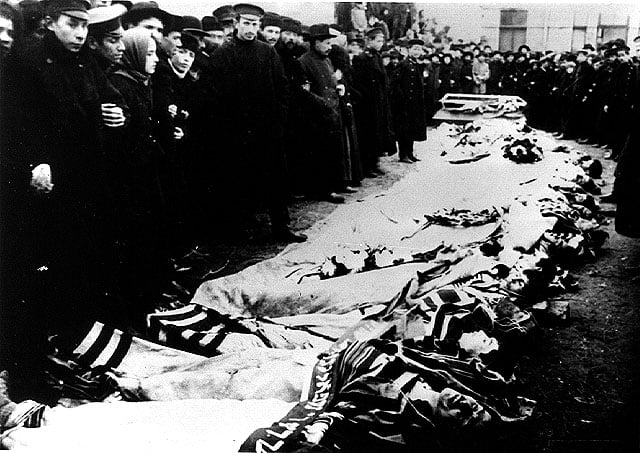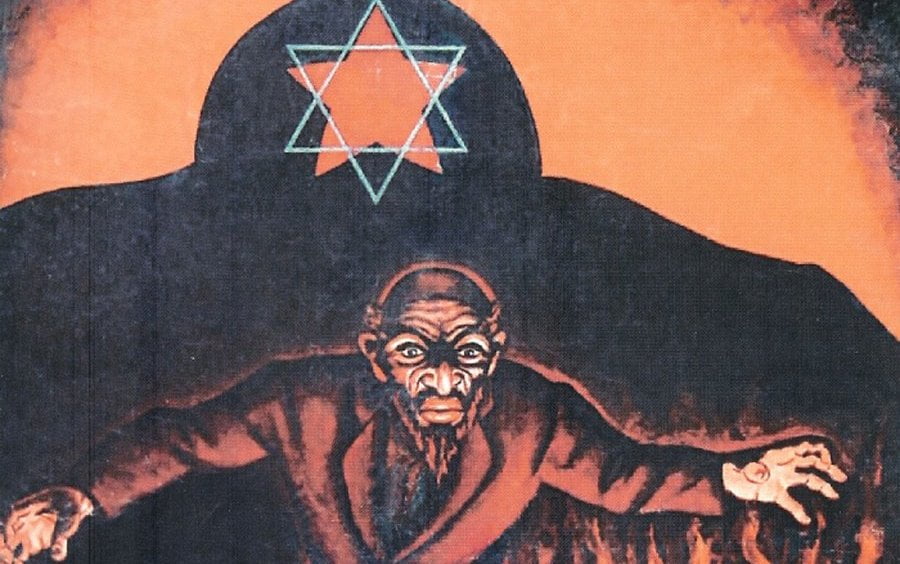For more than a hundred years, a theory has been popular among conspiracy theorists and anti-Semites in different countries about the plans of the Jews to establish world domination, allegedly set out in a special document. We figured out what historians think about this.
The Protocols of the Elders of Zion first became known at the beginning of the 20th century. In 1902, publicist Mikhail Menshikov wrote in the newspaper “Novoe Vremya” published the article “Conspiracy Against Humanity” - it spoke of the existence of a certain “rather thick manuscript” that contained a “secret conspiracy against the human race.” Document appeared in an abbreviated form a year later in the newspaper “Znamya”, in full - in 1905 in book Sergei Nilus “Great in small: the coming Antichrist and the kingdom of the devil on earth are near.” By the 1920s, the Protocols had been translated and published in Germany, Poland, France, Great Britain, USA and other countries. Even in the 21st century, they continue to be produced in printed form throughout the world.
The history of the origin of the Protocols is contradictory, even in the mouths of their first publishers. The same Nilus in 1905 stated, that he received the “Protocols” from a certain lady who stole the manuscript in France from a high-ranking Freemason during a certain secret meeting. Georgy Butmi in 1907 published a document in the book “Accusatory Speeches. Enemies of the human race,” adding a note to the text that the “Protocols” were obtained from “the secret vaults of the Zion General Office, now located on French territory.” Ten years later, Nilus changed his testimony, claiming that the manuscript was given to him by nobleman Alexei Sukhotin, and the “Protocols” themselves were presented in 1897 at First Zionist Congress in Basel. The introduction to the German edition of the book, also published in 1917, says that no manuscript was stolen in order to deliver it to St. Petersburg: the Zionists allegedly sent documents from Basel to Frankfurt am Main, Russian intelligence bribed the courier and somewhere along the way from one city to another they were able to make copies.
However, over the past hundred years, neither the original “Protocols” nor the copies allegedly taken by Russian intelligence have been presented to the public. Moreover, the content of this document varies significantly in different publications, including quantity these same protocols (the most common option out of 24). The wording contained in the text is extremely vague - it is very strange that the plan to take over the world does not describe the stages of its implementation, does not describe specific measures to achieve the stated goals, does not set clear deadlines, etc.
The portraits of those people who were the first to publish the “Protocols” are also indicative.
Mikhail Menshikov, who was the first to report the existence of this document, counts one of the largest and most influential conservative publicists at the turn of the 19th–20th centuries. In his works, Menshikov spoke about the growing influence of “non-Russian tribes” as a threat to Russia and demanded that representatives of “alien races” be limited as much as possible in politics and economics. The publicist also justified Jewish pogroms and proposed banning the admission of Jews to universities.
The Znamya newspaper, where the abridged version of the Protocols was first published, was headed by Pavel Krushevan. Over the years he published anti-Semitic articles, headed nationalist organizations, accused Jews of ritual murders. According to researchers, Krushevan’s activities largely led to pogrom of 1903 in Chisinau, during which 1,500 houses were destroyed and about 50 Jews were killed.
The publisher of the first “complete” text of the “Protocols” Sergei Nilus in his articles spoke about the approaching end of civilization and saw this as the result of a world conspiracy organized by the Jews. Similar views divided and Georgy Butmi, who participated in the preparation of the first editions of the “Protocols” and supported the Black Hundred movement.

One of the first revelations of the Protocols appeared in 1921. Journalist for the British newspaper The Times Philip Graves paid Please note that a significant part of them are borrowings from books Maurice Joly's Dialogues in Hell between Machiavelli and Montesquieu, published in 1864. According to Graves, about 40% of the text of the Protocols is based on fragments from Joly’s work, in nine of them borrowings make up more than half of the text, and Protocol No. 8 coincides almost word for word. The difference between the texts is that Joly was writing a political satire against the government of Napoleon III - the author (or authors) of the Protocols simply replaced the ministers with Jews. Despite Graves' discovery, publications of the Protocols around the world continued.
In 1938, another likely source from which the creators of the Protocols borrowed fragments, discovered Vladimir Burtsev. He drew attention to the similarities between many of the statements set out in the supposedly Zionist document and fragments from Hermann Goedsche's novel Biarritz (1868). One of the chapters of this work tells about a secret meeting of the “chosen ones of Israel” at the Jewish cemetery in Prague. From the lips of its participants sound the same theses about world domination, achievable thanks to money and the seizure of the press, which will later be reflected in the “Protocols”. Let us note that Goedsche did not hide his anti-Semitic views and for some time was a provocateur of the Prussian secret police.
Subsequently, numerous researchers around the world presented evidence of who and how could have falsified the Protocols.
British historian Norman Cohn assertsthat the document was created in France between 1897 and 1899 - while the trial was in progress Dreyfus, which gave rise to a widespread anti-Semitic campaign. Cohn clarifies that it is highly likely that the fake was created in Paris. According to him, the National Library has preserved a copy of Joly’s book with notes that are very similar to borrowings in the Protocols. At the same time, the historian is confident that the fabrication of the document is “the work of someone from Russia or a person belonging to the Russian right-wing political wing.” Perhaps this was done on the orders of the head of the agency in Paris, Pyotr Rachkovsky.
Cesare de Michelis in monographs "The Non-Existent Manuscript: A Study of the Protocols of the Elders of Zion" offers not only to trace the evolution of the Protocols, but also to pay attention to the text itself. Having resorted to textual analysis, the scientist concludes, that the “Protocols” were originally written in Russian (and not entirely correctly), and the French original source, apparently, never existed and was mentioned only in order to artificially increase the reliability of the document in the eyes of the public. De Michelis discovers in the supposedly French text Ukrainianisms, typically Russian words like “vodka,” and political terms from the turn of the 19th–20th centuries. The Italian scientist also rechecked the version of borrowings from the text of Maurice Joly - it turned out that the “Protocols” not only contain numerous exact quotes, but also many errors when translating from French into Russian. However, de Michelis does not share Kohn’s theory about the involvement of the head of the secret police in Paris in the creation of the Protocols. According to his conclusions, work on the “Protocols” was completed in Russia in 1903, and their author was Pavel Krushevan.
Another popular theory attributes the authorship of the “Protocols” to Matvey Golovinsky - this version was put forward in 1999 by the Russian historian Mikhail Lepyokhin and soon supported his Ukrainian colleague Vadim Skuratovsky. Golovinsky participated in the activities of anti-Semitic circles, and then, according to Lepyokhin and Skuratovsky, he went to work in Paris. In the newspaper Le Figaro, where he allegedly wrote pro-Russian materials on the instructions of Rachkovsky, his colleague was Charles Joly (probably the son of Maurice Joly), and in 1900 or 1901 Golovinsky began work on creating “Protocols”, which were then transported to St. Petersburg.
The authenticity of the “Protocols” was questioned not only by researchers, but also by government agencies several decades ago. In the mid-1930s, copies of the document were sold at an event in Bern; Swiss Jews sued over it. Witnesses at the trial performed Zionist representatives, historians, publicists, and even Philip Graves, who discovered plagiarism in the Protocols. During the hearing of the case, the judge came to the conclusion that the defendants are guilty of distributing “immoral” literature, and that the “Protocols” themselves are a fake. Although the case was reviewed in 1937 and the punishment was overturned, the court upheld the allegation of fraud.
Until now, the truly detective story around the origin of the “Protocols” is becoming a reason for research. Scientists establish the chronology of events and reveal more and more people participated in the creation of the text. Although it has not yet been possible to reach a final consensus on this issue, historians agree on one thing: “The Protocols of the Elders of Zion” is a forgery created in Russian at the turn of the 19th–20th centuries and has nothing to do with Jews in general or Zionists in particular.
Not true
- "Protocols of the Meetings of the Elders of Zion" (based on a 1905 publication by Nilus)
- V. Burtsev. "The Protocols of the Elders of Zion". Proven forgery / History of forgery-plagiarism
- N. Cohn. Warrant for Genocide: The Myth of the Jewish World-conspiracy and the Protocols of the Elders of Zion
- C. De Michelis. The non-existed manuscript: A study of the “Protocols of the Sages of Zion”
- L. Aronov, H. Baran, D. Zubarev. To the background of the “Protocols of the Elders of Zion”: Yu. D. Glinka and her letter to Emperor Alexander III
If you find a spelling or grammatical error, please let us know by highlighting the error text and clicking Ctrl+Enter.







